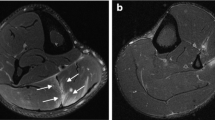Abstract
Objectives
To describe magnetic resonance imaging (MRI) characteristics of soleus muscle injuries in symptomatic professional football players stratified according to both the Munich consensus statement and the British Athletics Muscle Injury Classification (BAMIC), and to investigate the association between specific MRI features and the “return to play” (RTP).
Materials and methods
Professional football players with an episode of acute posterior calf pain and impaired function, subsequent to sports activity, underwent ultrasound followed by MRI examination reviewed by two different radiologists with more than 10 years of experience in the musculoskeletal system. MRI features and RTP outcome were evaluated for all types of injuries.
Results
During a 36-month period, a total of 20 professional football players were evaluated. According to the Munich consensus, 11 were type 3A, 8 were type 3B, and 1 was type 4, whereas according to the BAMIC, 11 lesions were considered grade 1, 4 grade 2, 4 grade 3, and 1 grade 4. RTP data were available for all patients (mean 3.3 ± 1.6 weeks). Both the Munich consensus and the BAMIC correlated with RTP (Spearman correlation = 0.982 and p < 0.0001 and 0.886 and p < 0.0001 respectively). Extension of edema was an independent prognostic factor for RTP in two different models of multivariate regression analysis (p = 0.044 model A; p = 0.031 model B).
Conclusions
The Munich consensus and BAMIC grading systems are useful tools for defining the patient’s prognosis and proper rehabilitation time after injury. The MRI feature that we should carefully look for is the extension of edema, as it seems to significantly affect the RTP.



Similar content being viewed by others
References
Ekstrand J, Hägglund M, Waldén M. Epidemiology of muscle injuries in professional football (soccer). Am J Sports Med. 2011;39(6):1226–32.
Elias JJ, Faust AF, Chu YH, et al. The soleus muscle acts as an agonist for the anterior cruciate ligament. An in vitro experimental study. Am J Sports Med. 2003;31(2):241–6.
Hodgson JA, Finni T, Lai AM, et al. Influence of structure on the tissue dynamics of the human soleus muscle observed in MRI studies during isometric contractions. J Morphol. 2006;267(5):584–601.
Garrett WE Jr. Muscle strain injuries. Am J Sports Med. 1996;24(6 Suppl):S2–8.
Balius R, Rodas G, Pedret C, et al. Soleus muscle injury: sensitivity of ultrasound patterns. Skeletal Radiol. 2014;43(6):805–12.
Koulouris G, Ting AYI, Jhamb A, et al. Magnetic resonance imaging findings of injuries to the calf muscle complex. Skeletal Radiol. 2007;36:921–7.
Lundgren JM, Davis BA. Endartery stenosis of the popliteal artery mimicking gastrocnemius strain: a case report. Arch Phys Med Rehabil. 2004;85(9):1548–51.
Bencardino JT, Rosenberg ZS, Brown RR, et al. Traumatic musculotendinous injuries of the knee: diagnosis with MR imaging. Radiographics. 2000;20:S103–20.
Koulouris G, Connell D. Hamstring muscle complex: an imaging review. Radiographics. 2005;25:571–86.
Gilbert TJ Jr, Bullis BR, Griffiths HJ. Tennis calf or tennis leg. Orthopedics. 1996;19(2):179. 182, 184
Millar AP. Strains of the posterior calf musculature ("tennis leg"). Am J Sports Med. 1979;7(3):172–4.
Noya J, Sillero M. Incidencia lesional en el fútbol profesional español a lo largo de una temporada: días de baja por lesión. Apunts Med Esport. 2012;47(176):115–23.
Orchard J, Best TM. The management of muscle strain injuries: an early return versus the risk of recurrence. Clin J Sport Med. 2002;12(1):3–5.
Orchard JW, Best TM, Mueller-Wohlfahrt HW, et al. The early management of muscle strains in the elite athlete: best practice in a world with a limited evidence basis. Br J Sports Med. 2008;42:158–9.
Brandser EA, el-Khoury GY, Kathol MH, et al. Hamstring injuries: radiographic, conventional tomographic, CT, and MR imaging characteristics. Radiology 1995;197:257–262.
O'Donoghue DH. Treatment of injuries to athletes. Philadelphia: Saunders; 1984. p. 742.
Kerkhoffs GMMJ, van Es N, Wieldraaijer T, et al. Diagnosis and prognosis of acute hamstring injuries in athletes. Knee Surg Sports Traumatol Arthrosc. 2013;21:500–9.
Connell DA, Schneider-Kolsky ME, Hoving JL, et al. Longitudinal study comparing sonographic and MRI assessments of acute and healing hamstring injuries. AJR Am J Roentgenol. 2004;183:975–84.
Ekstrand J, Healy JC, Waldén M, et al. Hamstring muscle injuries in professional football: the correlation of MRI findings with return to play. Br J Sports Med. 2012;46:112–7.
Askling CM, Tengvar M, Saartok T, et al. Acute first-time hamstring strains during high-speed running: a longitudinal study including clinical and magnetic resonance imaging findings. Am J Sports Med. 2006;35:197–206.
Slavotinek J. Muscle injury: the role of imaging in prognostic assignment and monitoring of muscle repair. Semin Musculoskelet Radiol. 2010;14:194–200.
Mueller-Wohlfahrt HW, Haensel L, Mithoefer K, et al. Terminology and classification of muscle injuries in sport: the Munich consensus statement. Br J Sports Med. 2013;47(6):342–50.
Pollock N, James SL, Lee JC, Chakraverty R. British athletics muscle injury classification: a new grading system. Br J Sports Med. 2014;48(18):1347–51.
Hayashi D, Hamilton B, Guermazi A, et al. Traumatic injuries of thigh and calf muscles in athletes: role and clinical relevance of MR imaging and ultrasound. Insights Imaging. 2012;3(6):591–601.
Maffulli N, Oliva F, Frizziero A, et al. ISMuLT guidelines for muscle injuries. Muscles Ligaments Tendons J. 2014;3(4):241–9.
Balius R, Alomar X, Rodas G, et al. The soleus muscle: MRI, anatomic and histologic findings in cadavers with clinical correlation of strain injury distribution. Skeletal Radiol. 2013;42(4):521–30.
Pedret C, Rodas G, Balius R, et al. Return to play after soleus muscle injuries. Orthop J Sports Med. 2015;22:3(7).
Ekstrand J, Askling C, Magnusson H, et al. Return to play after thigh muscle injury in elite football players: implementation and validation of the Munich muscle injury classification. Br J Sports Med. 2013;47:769–74.
Acknowledgements
We would like to thank Dr. Paolo Ferrero for his assistance in statistical analysis.
Author information
Authors and Affiliations
Corresponding author
Ethics declarations
Conflicts of interest
The authors declare that they have no conflict of interest.
Rights and permissions
About this article
Cite this article
Pezzotta, G., Querques, G., Pecorelli, A. et al. MRI detection of soleus muscle injuries in professional football players. Skeletal Radiol 46, 1513–1520 (2017). https://doi.org/10.1007/s00256-017-2729-z
Received:
Revised:
Accepted:
Published:
Issue Date:
DOI: https://doi.org/10.1007/s00256-017-2729-z




